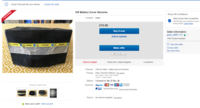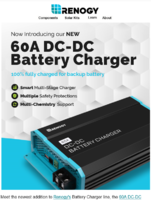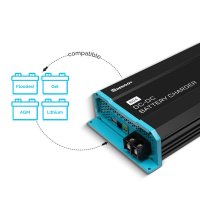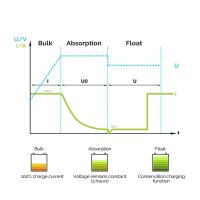!!! HAS RENOGY JUST SOLVED ALL OUR PROBLEMS IN ONE UNIT !!!!
Heres a new solution to LTD with Lifepo4 Batteries:
A 50A DC-DC charger with built in MPPT,
That has a lithium profile WITH Low Temp Disconnect,
That will reverse charge the starter battery !!!!!
That has a IGNITION feed for smart alternator.
************************************
.
DESCRIPTION
Renogy's DCC50S DC to DC MPPT on-board Battery Charger is designed to give you options! This multi-stage, multi-input battery charger can charge a service battery from an alternator connected to a starting battery or by utilizing solar panels connected directly to the unit. While your vehicle's alternator prioritizes your starting battery, this unit will allow your solar system to charge your service battery first! It's the smart way to keep yourself fully charged and off-grid longer! And with multi-stage charging and multi-chemistry functionality, Renogy's DC to DC MPPT Charger has you covered whether you're using Flooded, Gel, AGM, or Lithium batteries.
If you have any questions regarding this product, please call us at 1 (909) 287-7111 or email
sales@renogy.com.
KEY FEATURES
- Designed to charge service batteries from two DC inputs—solar panels and alternator.
- Built-in Maximum Power Point Tracking (MPPT) to maximize the solar power.
- 3-phase charging profile (Bulk, Boost, and Float) ensures your service battery will be accurately charged at the correct voltage levels to 100%.
- Built-in Voltage Sensitive Relay (VSR) for easy setup with traditional alternators.
- Compatible with smart alternators (with variable output voltage).
- Trickle charges the starting battery via solar panels if the service battery is fully charged.
- Isolation of the starting battery and the service battery.
- Temperature and voltage compensation features prolong battery life and improve system performance.
- Smart Protection Features: battery isolation, over-voltage protection, battery temperature protection, over-current protection, overheat protection, reverse current protection, solar panel and alternator reverse polarity protection.
- Compatible with multiple battery types: AGM, GEL, Flooded, and Lithium.
- Compact with a sturdy design, it was built tough for all conditions.
.
SPECIFICATIONS
System Voltage : 12VDC Battery Voltage Range : 9-16VDC
Maximum Charging Current : 50A (25A Alternator / 25A PV) Battery Type : SLA, GEL, FLD, LI, USER
Backup Battery Charging Mode : MPPT Charging Efficiency : Up to 97%
Max. Solar Input Voltage : 25V Maximum Solar Input Power : 660W
Alternator Input Voltage : Traditional Alternator: 13.2-16VDC Smart Alternator (Euro 6): 12-16VDC"
Maximum Alternator Input Power : 660W
Self-consumption : 60mA Operating Temperature Range : -22°F~149°F / ﹣35°C~65°C
Dimensions : 9.6 x 5.7 x 3.0 in / 244 x 146 x 77 mm Weight : 3.13 lbs / 1.42 kg
WARRANTY INFORMATION
Accessories 1-year material warranty
.
some details from the install,
.
.
.
.
.
.
.
.
************************************
DCC50S 12V 50A DC-DC On-Board Battery Charger with MPPT
https://www.renogy.com/content/RBC50D1S-G1/RRBC50D1S-G1-Manual.pdf
https://www.amazon.co.uk/Renogy-DC-..._1_3?keywords=renogy+dc&qid=1574256131&sr=8-3
***********************************
fwiw I've just gone on Amazon UK and grabbed one.





 Theres going to be a inch thick or so board behind or in front of each battery to fix the other paraphernalia too such as B2B charger, shunt for monitor etc, so thin ply can be screwed to the top of this to keep it in place and jobs a good-un
Theres going to be a inch thick or so board behind or in front of each battery to fix the other paraphernalia too such as B2B charger, shunt for monitor etc, so thin ply can be screwed to the top of this to keep it in place and jobs a good-un


